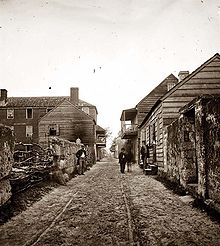British period[edit]
In 1763, the Treaty of Paris ended the Seven Years' War. Spain ceded Florida and St. Augustine to the British, in exchange for their relinquishing control of occupiedHavana.[54] With the change of government, most of the Spanish Floridians and many freedmen departed from St. Augustine for Cuba. Only a few remained to handle unsold property and settle affairs.
James Grant was appointed the first governor of East Florida. He served from 1764 until 1771, when he returned to Britain due to illness. He was replaced as governor byPatrick Tonyn. During this brief period, the British converted the monks' quarters of the former Franciscan monastery into military barracks,[55] which were named St. Francis Barracks. They also built The King's Bakery, which is believed to be the only extant structure in the city built entirely during the British period.
The Lieutenant Governor of East Florida under Governor Grant was John Moultrie, who was born in South Carolina. He had served under Grant as a major in the Cherokee War and remained loyal to the British Crown. Moultrie had three brothers who served in the Patriot army during the American War of Independence.[56]
Moultrie was granted large tracts of land in the St. Augustine vicinity, upon which he established the plantation of "Bella Vista." He owned another 2,000-acre (8.1 km2) plantation in the Tomoka River basin named "Rosetta".[57] While acting as the lieutenant governor, he lived in the Peck House on St. George Street.[58]
During the British period, Andrew Turnbull, a friend of Grant, established the settlement of New Smyrna in 1768. Turnbull recruited indentured servants from the Mediterranean area, primarily the island ofMinorca.[59] The conditions at New Smyrna were so abysmal[60] that the settlers rebelled en masse in 1777; they walked the 70 miles (110 km) to St. Augustine, where Governor Tonyn gave them refuge.[61][62] The Minorcans and their descendants stayed on in St. Augustine through the subsequent changes of flags, and marked the community with their language, culture, cuisine and customs.[63]
Second Spanish period[edit]
The Treaty of Paris in 1783 gave the American colonies north of Florida their independence, and ceded Florida to Spain in recognition of Spanish efforts on behalf of the American colonies during the war.
On September 3, 1783, by Treaty of Paris, Britain also signed separate agreements with France and Spain. In the treaty with Spain, the colonies of West Florida, captured by the Spanish, and East Florida were given to Spain, as was the island of Minorca, while the Bahama Islands, Grenada and Montserrat, captured by the French and Spanish, were returned to Britain.[64][65]
Florida was under Spanish control again from 1784 to 1821. There was no new settlement, only small detachments of soldiers, as the fortifications decayed. Spain itself was the scene of war between 1808 and 1814 and had little control over Florida. In 1821 the Adams–Onís Treaty peaceably turned the Spanish provinces in Florida and, with them, St. Augustine, over to the United States. There were only three Spanish soldiers stationed there in 1821.[66]
A relic of this second period of Spanish rule is the Constitution monument, an obelisk honoring the Spanish Constitution of 1812,[67] one of the most liberal of its time. In 1814 King Ferdinand VII of Spain abolished that constitution and had monuments to it torn down; the one in St. Augustine is said to be the only one to survive.[68][69]
American period[edit]
See also: St. Augustine in the American Civil War
Florida was ceded to the United States by Spain in the 1819 Adams–Onís Treaty,[70] ratified in 1821; Florida officially became a U.S. possession as the Florida Territory in 1822.[71] Andrew Jackson, a future president, was appointed its military governor and then succeeded by William Pope Duval, who was appointed territorial governor in April 1822.[72] Florida gained statehood in 1845.
After 1821, the United States renamed the Castillo de San Marcos (called Fort St. Marks by the British) "Fort Marion" in honor of Francis Marion,[73] known as the "Swamp Fox" of the American Revolution.
During the Second Seminole War of 1835–1842, the fort served as a prison for Seminole captives, including the famed leader Osceola, as well as John Cavallo (John Horse) the black Seminole and Coacoochee (Wildcat), who made a daring escape from the fort with 19 other Seminoles.[74][75]
In 1861, the American Civil War began; Florida seceded from the Union and joined the Confederacy. On January 7, 1861, prior to Florida's formal secession, a local militia unit, the St. Augustine Blues, took possession of St. Augustine's military facilities, including Fort Marion[76]and the St. Francis Barracks, from the lone Union ordnance sergeant on duty. On March 11, 1862, crew from the USS Wabash reoccupied the city for the United States government without opposition.[76][77][78] It remained under Union control for the remainder of the war.[79] In 1865, Florida rejoined the United States.
After the war, freedmen in St. Augustine established the community of Lincolnville in 1866, named after President Abraham Lincoln. Lincolnville, which had preserved the largest concentration of Victorian Era homes in St. Augustine, became a key setting for the Civil Rights Movement in St. Augustine a century later.[80]
After the Civil War, Fort Marion was used twice, in the 1870s and then again in the 1880s, to confine first Plains Indians, and then Apaches, who were captured by the US Army[81]in the West.[82] The daughter of Geronimo was born at Fort Marion,[83][84] and was named Marion. She later changed her name. The fort was also used as a military prison during the Spanish–American War of 1898.[85] It was removed from the Army's active duty rolls in 1900[86] after 205 years of service under five different flags. It is now run by theNational Park Service, and is preserved as the Castillo de San Marcos National Monument, a National Historic Landmark.[87



No comments:
Post a Comment